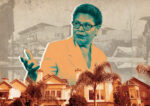Trending
In downtown real estate, just add water

Marquis Miami
Miami’s high-end real estate market has developed a typical buyer profile: wealthy, probably from South America (especially Brazil), and looking to take advantage of a strong currency for a second home.
New numbers from 2010 show another trend: these buyers are looking for waterfront properties, and they’re willing to pay a premium for them.
“It primarily goes to the age-old rule of location, location, location,” said Beth Butler, president of One Sotheby’s International Realty. “Waterfront is always going to be desirable, and when you’ve gone through the market downturn like we have, waterfront is the last to fall, and the first to bounce back.”
According to a “Trends” report compiled by One Sotheby’s, buyers paid a premium to be closer to the water in 2010, with a jump in waterfront sales and a drastic divide between properties on the water and those that are not.
In Brickell, for example, 612 waterfront condo units sold in 2010, for an average price of $408,119. Just 218 non-waterfront properties sold for an average of $194,003, according to the report, which is based on MLS data.
In downtown Miami, the numbers were similar. There were 150 condo units sold along downtown Miami’s waterfront last year, for an average sales price of $243,564. Off the water, 71 condos sold with an average sales price of $196,290.
“There’s no question that the waterfront properties are more desirable, especially by international buyers,” said EWM President Ron Shuffield.
Of course, there are substantially more properties on the water in Miami than existed five or ten years ago.
The waterfront-non-waterfront divide, as seen in the downtown-Brickell microcosm, is part of a growing trend that has buyers still looking for properties on the east side of the I-95 divide.
“When you look at [the data], especially the 20-something, 30-something buyer, it seems like the overwhelming majority of people in those age brackets are looking at the east side, both in Dade and Broward,” Shuffield said.
Brickell’s waterfront sales (all of which are condos) jumped 23 percent last year, along with a 12 percent jump for non-waterfront, downtown Miami actually saw 21 percent fewer sales in each category, likely a sign of decreased inventory, and a sign prices could be increasing, Butler said.
“As inventory decreases, ultimately what will happen sometime this year, whether it’s [second quarter] or later, you’ll see the prices increase a bit in on the waterfront. If somebody wants waterfront, they’ll pay a little more than they did last year.”
According to One Sotheby’s, just 5,000 units remain on the market in downtown Miami, which began the downturn with as many as 62,000 projected to be constructed after 2005. By the last quarter of last year, only 17,502 were completed.
As inventory falls, however, buyers will move west, looking towards buildings with water views if they can’t find ones with direct water frontage, Shuffield said.
“A lot of people are looking as much for a water view across from the bay from downtown Brickell as they are looking to be on the beach,” he said.




